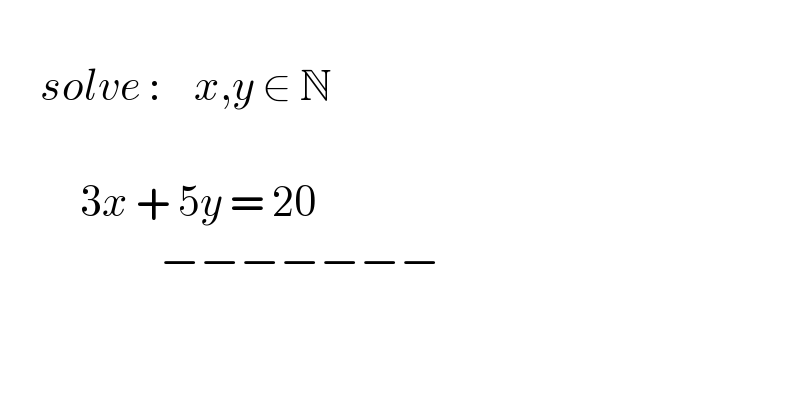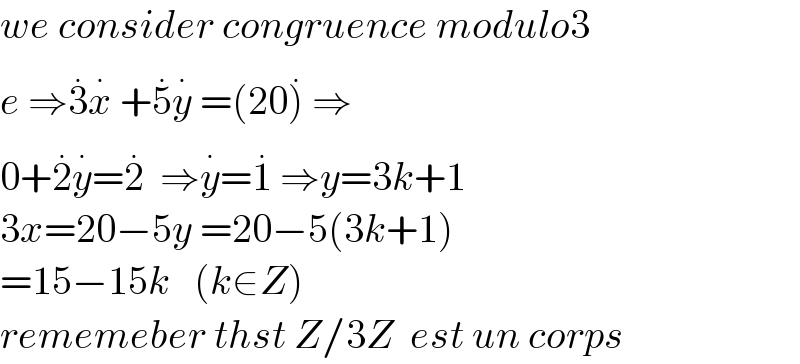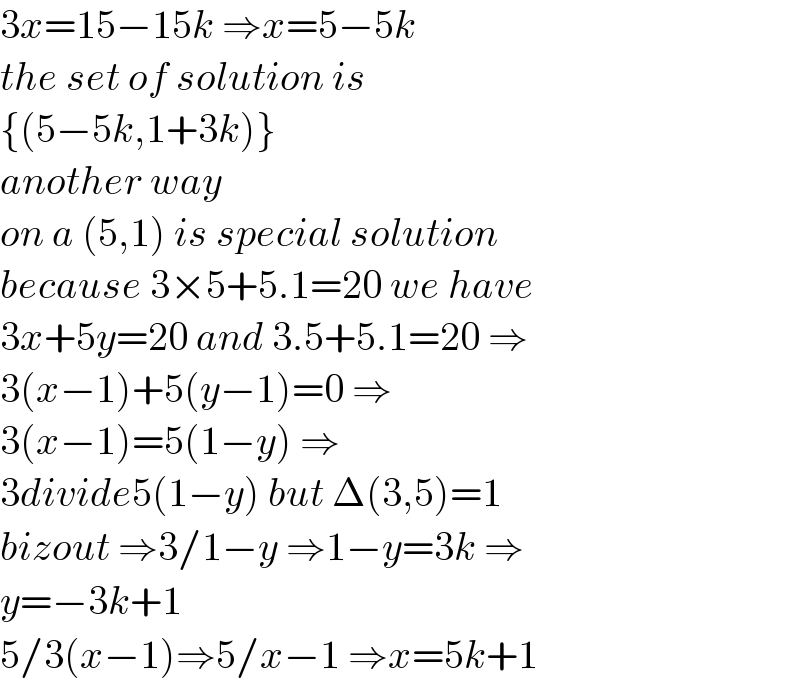Question Number 163770 by mnjuly1970 last updated on 10/Jan/22

$$ \\ $$$$\:\:\:\:\:{solve}\::\:\:\:\:{x},{y}\:\in\:\mathbb{N}\: \\ $$$$\:\:\: \\ $$$$\:\:\:\:\:\:\:\:\:\:\mathrm{3}{x}\:+\:\mathrm{5}{y}\:=\:\mathrm{20}\:\:\:\:\: \\ $$$$\:\:\:\:\:\:\:\:\:\:\:\:\:\:\:\:\:\:\:\:−−−−−−− \\ $$
Answered by MJS_new last updated on 10/Jan/22

$${y}=\mathrm{4}−\frac{\mathrm{3}}{\mathrm{5}}{x}\:\Rightarrow\:\left({x}=\mathrm{0}\wedge{y}=\mathrm{4}\right)\vee\left({x}=\mathrm{5}\wedge{y}=\mathrm{1}\right) \\ $$
Commented by MJS_new last updated on 10/Jan/22

$$\mathrm{yes},\:\mathrm{thank}\:\mathrm{you}! \\ $$
Commented by MathsFan last updated on 10/Jan/22

$${sir},\:{which}\:{method}\:{did}\:{you}\:{use}\:{please} \\ $$
Commented by MJS_new last updated on 10/Jan/22

$$\mathrm{it}'\mathrm{s}\:\mathrm{obvious}\:\mathrm{for}\:{x},\:{y}\:\in\mathbb{N},\:\mathrm{no}\:\mathrm{special}\:\mathrm{method} \\ $$$$\mathrm{needed}. \\ $$$$\mathrm{3}{x}+\mathrm{5}{y}=\mathrm{20}\:\Leftrightarrow\:{y}=\mathrm{4}−\frac{\mathrm{3}}{\mathrm{5}}{x}\:\Rightarrow \\ $$$$\Rightarrow\:{x}=\mathrm{5}{n}\:\Rightarrow\:{y}=\mathrm{4}−\mathrm{3}{n}\:\Rightarrow\:{n}=\mathrm{0}\vee{n}=\mathrm{1} \\ $$
Answered by Mathspace last updated on 10/Jan/22

$${we}\:{consider}\:{congruence}\:{modulo}\mathrm{3} \\ $$$${e}\:\Rightarrow\overset{.} {\mathrm{3}}\overset{.} {{x}}\:+\overset{.} {\mathrm{5}}\overset{.} {{y}}\:=\left(\mathrm{20}\overset{.} {\right)}\:\Rightarrow \\ $$$$\mathrm{0}+\overset{.} {\mathrm{2}}\overset{.} {{y}}=\overset{.} {\mathrm{2}}\:\:\Rightarrow\overset{.} {{y}}=\overset{.} {\mathrm{1}}\:\Rightarrow{y}=\mathrm{3}{k}+\mathrm{1} \\ $$$$\mathrm{3}{x}=\mathrm{20}−\mathrm{5}{y}\:=\mathrm{20}−\mathrm{5}\left(\mathrm{3}{k}+\mathrm{1}\right) \\ $$$$=\mathrm{15}−\mathrm{15}{k}\:\:\:\left({k}\in{Z}\right) \\ $$$${rememeber}\:{thst}\:{Z}/\mathrm{3}{Z}\:\:{est}\:{un}\:{corps} \\ $$
Commented by Mathspace last updated on 10/Jan/22

$$\mathrm{3}{x}=\mathrm{15}−\mathrm{15}{k}\:\Rightarrow{x}=\mathrm{5}−\mathrm{5}{k} \\ $$$${the}\:{set}\:{of}\:{solution}\:{is} \\ $$$$\left\{\left(\mathrm{5}−\mathrm{5}{k},\mathrm{1}+\mathrm{3}{k}\right)\right\} \\ $$$${another}\:{way} \\ $$$${on}\:{a}\:\left(\mathrm{5},\mathrm{1}\right)\:{is}\:{special}\:{solution} \\ $$$${because}\:\mathrm{3}×\mathrm{5}+\mathrm{5}.\mathrm{1}=\mathrm{20}\:{we}\:{have} \\ $$$$\mathrm{3}{x}+\mathrm{5}{y}=\mathrm{20}\:{and}\:\mathrm{3}.\mathrm{5}+\mathrm{5}.\mathrm{1}=\mathrm{20}\:\Rightarrow \\ $$$$\mathrm{3}\left({x}−\mathrm{1}\right)+\mathrm{5}\left({y}−\mathrm{1}\right)=\mathrm{0}\:\Rightarrow \\ $$$$\mathrm{3}\left({x}−\mathrm{1}\right)=\mathrm{5}\left(\mathrm{1}−{y}\right)\:\Rightarrow \\ $$$$\mathrm{3}{divide}\mathrm{5}\left(\mathrm{1}−{y}\right)\:{but}\:\Delta\left(\mathrm{3},\mathrm{5}\right)=\mathrm{1} \\ $$$${bizout}\:\Rightarrow\mathrm{3}/\mathrm{1}−{y}\:\Rightarrow\mathrm{1}−{y}=\mathrm{3}{k}\:\Rightarrow \\ $$$${y}=−\mathrm{3}{k}+\mathrm{1} \\ $$$$\mathrm{5}/\mathrm{3}\left({x}−\mathrm{1}\right)\Rightarrow\mathrm{5}/{x}−\mathrm{1}\:\Rightarrow{x}=\mathrm{5}{k}+\mathrm{1} \\ $$
